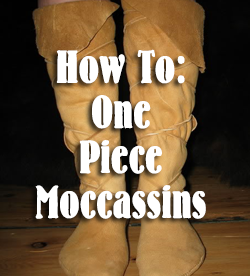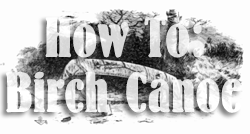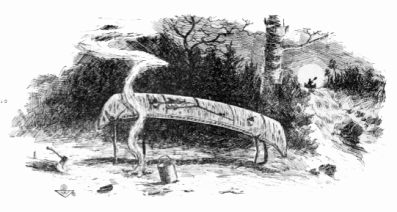
The Building of a Birch Canoe
By Tappan Adney
Taken From: Outing Magazine ©1900
When the sky shall be no longer blue and fair, and brooks shall cease to sing the song of summer, and lordly moose no longer tear the lily from its bed of mud, and lusty trout no longer flirt and jump for very love of living; when smiling birch and sombre spruce, and all nature, shall break their spell and cease to beckon, then, but not till then, shall I no longer love the birch canoe.
Perhaps my association of the red man's primitive craft with the woods and wild living things of the North, is because my first and most vivid impression of that region is of the building of a certain birch canoe, whose graceful form, as it grew from day to day under the magic hand of its Indian builder, I watched with boyish eagerness.
Peter Joseph, or "Pete Joe," as many preferred to call him, lived with aged Nokomis and a bright nephew of ten years, in a small house built of birch-bark, under the shade of some elms on a grassy point where Lane's Creek, bearing its smell of fresh, green, mossy woods, poured into the Wallastook, or St. John River - a situation such as Indians, everywhere in the East and North, are fond of choosing for their summer habitations. There were two or three other families, at or near "The Point," as the Indian settlement was known, all Milicites, or as they call themselves, "Wallastook-people," whose occupation may be described as chiefly basket- making; the men helping the squaws at this work, when not otherwise employed in spearing salmon, hunting moose, trapping, canoe-building, or guiding parties of sportsmen, according as their several tastes or necessity dictated and the season allowed.
An Indian, taught from boyhood the arts of woodcraft, becomes adept to a considerable degree in those matters which are part of his daily life; but they freely recognize among their number any who possess special skill, whether in calling moose or building canoes. And so, along the St. John River, while there were many who in some fashion could build a birch canoe, those whose canoes were known for their model and substantial build could be counted on the fingers of one hand. One of these was Peter Joe, although sometimes his name would be mentioned slightingly by younger and more progressive Indians, who, having learned from white men the commercial value of time, had acquired the habit of throwing things together with nails and tacks, instead of patiently split sewings of root and fibre. He was about sixty years of age, reserved in manner, and dignified in expression; a kindly old man, willing to answer a boy's foolish questions about the names of birds and animals; explaining, while engaged at his labor, how to split and resplit the basket-ash, until it was but a thin, flat thread; how to bend the cedar without breaking, or how the jaws of the spear spring apart to grip the struggling salmon - everything a boy would want to know.
One day, after the snow had gone and the sap had started coursing through the trees; at that season when the air is laden with the smell of new leaves and opening buds, Peter announced that it was about time for bark to peel well, and if he could find a suitable piece of bark he would build a canoe.
The canoe - or paper-birch - Betida papyrifera - locally known as "gray-birch," to distinguish it from the "white-birch " of the " burnt land," is a plentiful tree in its northern range, but the quality of the outer bark, upon which depends the service of a canoe, varies exceedingly, and trees with the requisite thickness and toughness of bark, and of length and smoothness of trunk, are exceedingly scarce.
There are two kinds of canoe-bark., known as ''winter-bark " and " summer- bark." Ordinarily, during the period when sap is not flowing, it is impossible to peel the bark off the birch, except in strips perhaps no wider than one's hand; and the frost of winter, which freezes the tree as hard as iron, is another obstacle to the removal of the bark. But, during warm, rainy spells in winter, fires can be employed to thaw the bark, which from the great amount of resin it contains, becomes pliant under heat; and by using care, with the help of wedges, it can be stripped from the tree. "Winter-bark" is thought to be tougher than "summer-bark," but the danger of spoiling a fine piece is such that the risk is not often taken. It is a "summer-bark " canoe that I am about to describe.
About three miles back from the river, was a grove of canoe-birches, to which the Indians for fifty miles around resorted for canoe-bark. But the trees, though covering a considerable extent of ground, were so scattered among maples, spruce, and yellow birch that the existence of the grove was known to comparatively few white people.
We set out from the camp one morning in June, with only our axes, and the Indian's hunting-knife, took the highway for a mile or two, beyond the first tier of farms, and then plunged into the primeval forest. The gray and white forms of the birches began to appear among the others, and the Indian went from tree to tree, chipping a piece of bark from each, near the butt, so as not to spoil a possibly good piece. This bark was too thin, the "eyes " of that were too numerous and large. In others the bark was prime, but the trunk was neither straight, nor tall, nor large, nor free from knots.
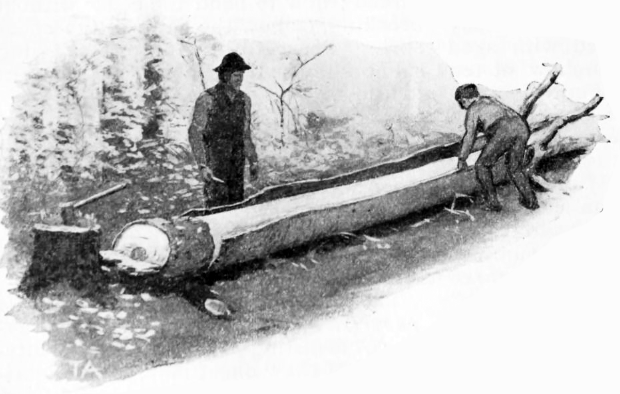
Peeling the Bark from Tree.
"Sartin, I spose them Injuns from Tobique git all the good bark," said Peter, as he bent and twisted a sliver of bark and tossed it upon the ground, and looked around for another tree.
Finally, after I had begun to think we should not find one that suited, we came to a tree which reared its head high above those in its neighborhood; tall, twenty feet to the lowest limb, sixteen inches through at the butt, with thick, heavy, fine-eyed bark - a perfect specimen of a canoe-birch.
"How are you going to peel the bark, Peter?" I asked, thinking that some sort of scaffolding would have to be erected around the tree.
"'Y gorry, we peel-um all right," replied the Indian, as he looked upwards, as if sighting for some purpose. Then he began clearing away the undergrowth on one side of the tree, and I fell to work with my axe, without asking any more questions. When we had done this, he felled a sapling about as big as a man's leg, and cutting off a piece five or six feet long laid this upon the ground close to the butt of the canoe-tree. Then I understood that we were going to cut the tree down, and that the log was to prevent the birch when it fell from burying itself in the soft moss, which everywhere carpeted the ground. We put our axes to the butt, Peter making the inside cut, and in a few moments the tree began to crack, md then with a few well directed cuts on the outside, toppled and fell with a smash, exactly where the Indian intended. The sapling at the butt, and the limbs of the tree itself at the top, held the trunk clear of the ground by several inches.
"Sartin, that's good piece of bark. Make-um good canoe this time," said the Indian, as he sat down on the log and inspected the fallen trunk
We started peeling the bark. The Indian, with his hunting-knife, made a cut encircling the butt, and another around the other end, connecting them with a straight cut along the top. Lifting the edges carefully along the entire length of the cut, and gradually working with our hands, in a short while the fine, yellow bark, in one sheet, eighteen feet long and over three feet wide, and without a blemish, was freed and fell to the ground.
Peter Joe built a fire of scraps of birch - bark, and then warming the sheet over the fire to make it pliant, we rolled it up as one would a carpet, and lashed it together with bands of cedar-bark, or "Injun rope," with an additional sling for carrying over the shoulders.
Before we left the grove we found a smaller tree, which we peeled in like manner, and then each taking up his load of thirty or forty pounds, we returned to the-camp. There Peter placed the larger roll in the river, weighting it down with stones, and anchoring it securely to the shore with "Injun rope."
The order in which a birch canoe is put together is exactly the reverse of what a person familiar with ordinary boat or ship-building would suppose. Instead of first laying a keel and constructing thereon a frame of ribs of exact shape of the finished craft, and then covering this mould with sheathing, the sheathing, or bark, of the canoe is put directly into a shape as near the finished form as possible, and the ribs, which are bent beforehand, each to its right form, are placed in afterwards.
Each tribe of Indians in the birch-country makes a style of canoe differing more or less from those of other tribes. They vary in outward appearance from the curiously "humped" canoe of the Restigouche River, in New Brunswick, to the small, half-kyak form of the Klondike, but in all the same peculiarity in construction is to be observed.
The woodwork of our canoe was to be of clear, straight-grained cedar, and only the heart at that. With an eye to the future, Peter had watched for and discovered among the thousands of logs that floated past the camp during the spring "drive " of the lumbermen, a fine cedar that was unmarked, and therefore, according to common usage, was his for the finding. He had speared it with his pike-pole, and drawn it out on shore. Except for this good fortune we should probably have had a long search for a tree to answer the purpose.
While the bark was soaking Peter split the cedar log, and with his "crooked-knife " whittled out two strips an inch and a half square and about six- teen feet long. These, which he called the "gunwales," he lashed together at the ends with spruce roots, and braced them apart, like two bows, with five rock-maple cross-bars, the middle one being thirty inches long.
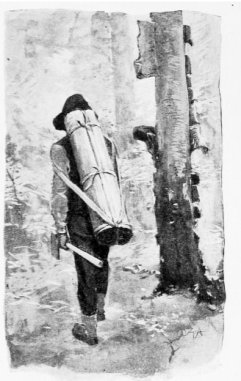
Carrying in the Bark.
The "crooked-knife" is an implement used by woodsmen, both white and red, wherever in British North America I have been. In the East I was inclined to think it rather an invention of the lumbermen, until I saw in use by the Indians on the Klondike River a knife in every respect the same as that used by Peter Joe on the banks of the St. John. It consists of a thick, narrow blade, about three inches long; sometimes straight, but usually with a more or less distinct curve. This blade is set into a wooden handle, shaped so that it may be grasped in one hand, with the thumb pressing against a flat place, the handle being given a turn, like a fiddle-head, for that purpose. The workman sits on the ground or a low stool, with the piece to be shaped in the left hand, and the knife, held dagger fashion, is drawn to- ward him with a long sweeping motion, removing thin shavings as perfectly as a plane or draw-knife.
The crooked-knife user becomes so accustomed to whittling this way that he very seldom whittles " away " from himself, even when cutting a stick in two.
The ribs were taken out of the best part of the cedar. They must be split with their flat sides parallel with the bark. If taken with the edges toward the bark across the grain, they will not bear the strain of bending. The ribs, to the number of forty or fifty, and about as wide as one's hand, and half an inch thick, carefully smoothed by means of the crooked knife, were soaked for several days in the river, and then bent, two at a time, hot water being poured over them to increase their pliancy. It is remarkable how each pair of ribs is bent beforehand to the exact form of the finished canoe, every other pair having a different curve, as though the builder saw in his mind's eye the finished form of the canoe. Here is shown the experience of the canoe-builder. After the ribs are bent to the right shape loops of cedar-bark are put around to keep them in place, and then they are laid in the sun to become perfectly dry, when the bands may be taken off and the ribs will retain their shape.
While the ribs were seasoning, Peter leveled off a piece of ground near the camp twenty feet long and a yard wide. It is not quite correct to say " leveled," for although to the eye the ''bed," as it is termed, appeared level, it was about two inches higher in the middle than at the ends. This raising of the middle is positively necessary. Sometimes, instead of bare ground being used for the bed, a platform of boards is used, whereby the middle can be raised, as already described, with less trouble.
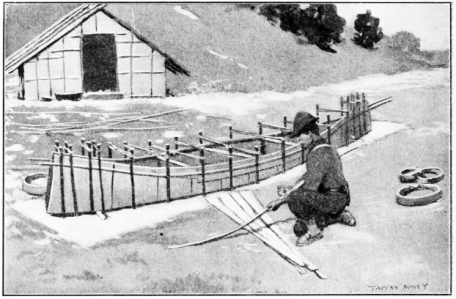
Shaping the Model.
The gunwales were now placed upon the bed, and the two ends supported upon pegs two inches high. Then twenty to thirty stakes, two to three feet long, were driven into the ground around the gunwales, at intervals of about a foot. When this was done, every stake was pulled up and put aside, each beside its own hole.
The gunwales were next taken up, and the bark unrolled and spread out on the bed, with the yellow, or outer, side down. The gunwales were then put back on top the bark and weighted with heavy stones. It was fascinating to follow each step, wondering how many generations of canoe-builders it had taken, that this Peter Joseph should be able, without a mistake, to build a boat thus "backwards."
The bark had now to be bent upright around the frame. But to do this, little V-shaped slices or gores had to be taken out every foot or so, along each side of the bark; and then without difficulty each flap was bent up, and as this was done each stake was slipped back into place to hold it there.
Next the gunwales were raised (the bark remaining flait upon the ground), and under the end of each cross-bar was placed a post.
Two eighteen-foot strips of cedar were pushed inside the stakes and lashed through the bark to the gunwales, thus securing the edges of the bark firmly.
The next thing was to place the canoe upside down on two "horses" and round off the ends, either by the eye, or with the help of a pair of wooden dividers. A thin bent stick of wood was slipped in between the edges of the bark, bow and stern, and sewn over and over with roots. The canoe was then turned over on the grass and the larger holes and cracks pasted up with strips of bark and a "pitch" made of certain parts of pine-rosin and grease. The inside was then lined completely with very thin strips of cedar running lengthwise, and the ribs, which were by this time as dry as a bone, were driven one by one into place, commencing at the ends and ending amidship. A narrow oval board was set into the two ends, which had been stuffed with shavings, and a long strip of cedar nailed on top of the gunwales, and lashed at the ends. The cracks outside were then plastered with pitch, which practically finished the canoe, upon which Peter Joe had worked three weeks.
Before the canoe was placed in the river it was partially filled with water, which immediately disclosed some holes that had escaped observation, and these were plastered with pitch.
Canoe-bark is at first a bright golden yellow, which soon turns upon exposure to a rich golden or reddish brown. This after many years' service becomes quite gray.
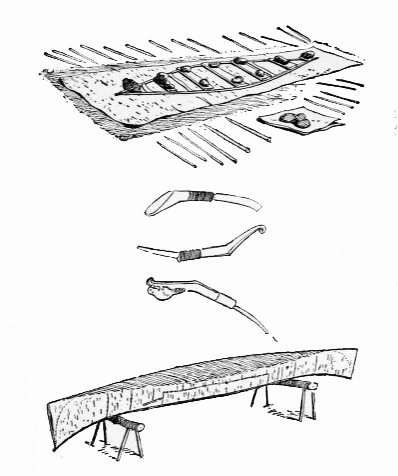
"Winter-bark," in being stripped from the tree, brings up some of the under bark, and this after a little while turns a rich red. This surface, being somewhat rough, must be scraped off by wetting the bark; but usually portions of the red color may be left on, in the form of a decoration several inches wide below the gunwale, like a necklace or garland around the entire canoe. Often, on the finest canoes, some figure, as a star or an animal, or a bold Indian hunter with a tomahawk, maybe seen, together with the maker's mark or name. White men now make canoes of canvas, following the lines of the birch, and these are thought by many to be superior to the birch. Birch canoes are still in general use, but it would seem that unless the birches grow faster than the Indians are stripping them, the time is not far distant when the birch canoe will exist only in museums, and in the memory of lovers of wood-craft.
I never thought to ask Peter his opinion of a canoe built of cedar "limbs," like the legendary one that floated on the river "Like a yellow leaf in autumn - Like a yellow water-lily."
I am certain, however, that Peter, careful workman that he was would have regarded the canoe constructed in the imagination of Mr. Longfellow, as "mutjego ahgwed'n - sartin, very poor canoe."
But then, as Mr. Burroughs has somewhere remarked, referring to a similar poetic license, one should not "smelt the poet's gold in the naturalist's pot."



